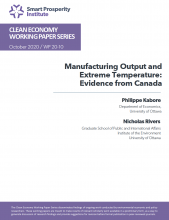By Philippe Kabore and Nicholas Rivers
This working paper analyzes the effects of extreme temperature on manufacturing output using a dataset covering the universe of manufacturing establishments in Canada from 2004 to 2012. Extreme temperature can affect manufacturing activity by individually or jointly influencing labour productivity and labour inputs. Using a panel fixed effects method, our results suggest a non-linear relationship between outdoor extreme temperature and manufacturing output. Each day where outdoor mean temperatures are below -18oC or above 24oC reduces annual manufacturing output by 0.18% and 0.11%, respectively, relative to a day with a mean temperature between 12 and 18oC. In a typical year, extreme temperatures, as measured by the number of days below -18oC or above 24oC , reduce annual manufacturing output by 2.2%, with extreme hot temperatures contributing the most to this impact. Given anticipated changes in temperatures over the coming decades, we predict annual manufacturing output losses in Canada to range from 2.8 to 3.7% by mid-century and 3.7 to 7.2% by the end of century.
READ THE WORKING PAPER: Manufacturing Output and Extreme Temperature - Evidence from Canada
The Clean Economy Working Paper Series disseminates findings of ongoing environmental and clean economy work conducted by researchers from a range of disciplines. These working papers are meant to make results of relevant scholarly work available in a preliminary form. Although these papers have not undergone a peer-review process, they meet general standards of scholarly excellence. The views expressed in these working papers are those of the authors and do not necessarily reflect the opinions of Smart Prosperity Institute.




